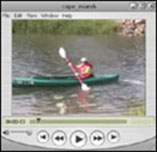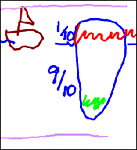Learning Elements
Overview of the GEOSC 10 Multimedia
You will find that we utilize a lot of “sites” and sounds in this course to help bring geology "alive" for you! The primary multimedia components you will encounter are video-based lectures, "GeoClips" and "GeoMations." Each component is designed to provide emphasis, or a different angle, and a personal touch to important topics and concepts in this course. Many of the materials you'll see came from fellow students who worked on an award-winning project that was part of a course entitled CAUSE 2004 (Center for Advanced Undergraduate Study and Experience) and involved the GEOSC 10 team, the Dutton e-Education Institute, and Penn State Public Broadcasting.
Recommended Browsers and Computers
Please use a Canvas-supported browser. Failure to do so can result in problems viewing integral course material and quiz images.

GeoClips
"GeoClips" attempt to visualize many complex ideas and concepts for you by presenting them in creative ways and by drawing connections to everyday life. Many of the "GeoClips" presented in this course are the work of the 12 students who participated in CAUSE 2004, who, as part of the course, accompanied Drs. Anandakrishnan and Alley and Eric Spielvogel on a 3-week geology expedition to the American Southwest during May of 2004. CAUSE 2004 students were given the task of planning, filming, and editing short pieces about geology while capturing the beauty of the National Parks of the Southwest so that future students like yourselves could experience these National treasures and learn a bit about their geology along the way. We're confident that they did their job by helping to create an inventory of video clips that are both appealing and informative, and that these video resources will help you gain a greater sense of the big ideas in each of GEOSC 10's units.

GeoMations
"GeoMations" are computer-generated illustrations drawn by Dr. Anandakrishnan or Dr. Alley, and include voice narration. Each one is designed to visually demonstrate or explain a particular process or phenomenon for you. Fortunately, these guys LOVE to draw, because Geology is a very visual subject and without drawings like these, it would be a lot more challenging to learn.
OPTIONAL:
If you would like a little more background on the experience of the students and professors getting up close and personal with the national parks, check out the trailer for "15 Minutes: Geology of the National Parks," a public-broadcasting discussion of the CAUSE class that produced so many of the wonderful things you'll see in this course.
These multimedia elements are important to you because they:
- are instructive and informative;
- help reinforce important unit ideas;
- provide you with some different takes and angles on the material;
- give the visual and media-savvy learners additional connecting points to the content;
- and yes, they are meant to be enjoyable, too!
You are accountable for these in the same way you're expected to know the material from the online text and from any of the other learning resources made available to you. The main reason these are here is to help you better visualize and learn important unit topics; despite the lighthearted approach taken in many of them, they're crucial to your success in this course since questions based on them will appear regularly on unit quizzes and on the final. So enjoy them, of course, but don't forget to make them part of your weekly study routine so that you benefit from the information they contain.